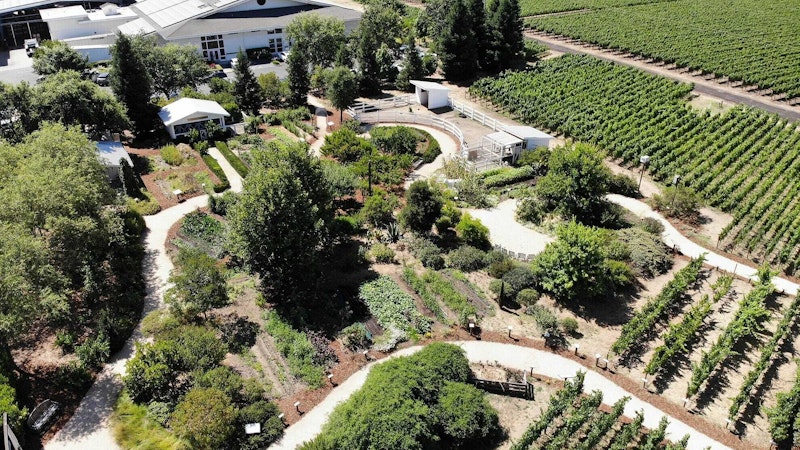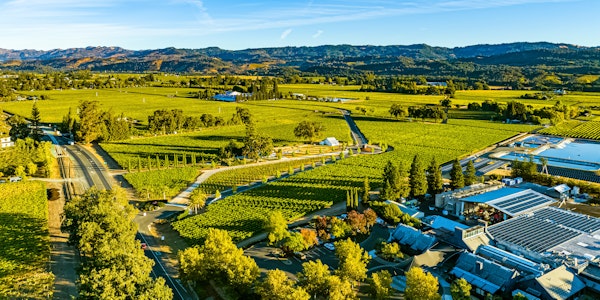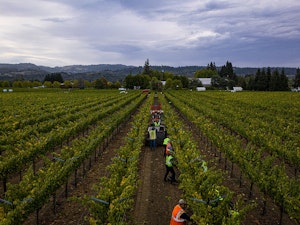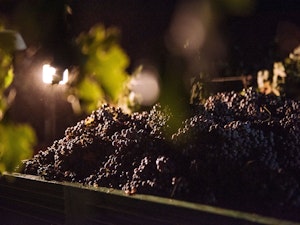explore our
Vineyards

Raymond Vineyards has over 170 acres of estate vineyards in the Napa Valley in two appellations.
Each parcel is matched to varietals that perform well in that particular climate and soil type. In addition, we maintain long-term growing contracts with over 15 napa valley growers, allowing us to take advantage of the micro-climates and sub-appellations within the napa valley.
St. Helena Vineyards

Nestled in the heart of Napa Valley, Raymond’s 64-acre estate vineyard in St. Helena is a showcase of sustainability and excellence. Certified Organic by CCOF and Biodynamic® by Demeter, this meticulously maintained vineyard lies on the valley floor, just north of the Rutherford estate and south of the city of St. Helena. The historic Founder’s Ranch Vineyard block, planted in 1976, thrives in gravelly alluvial fan soils that provide exceptional drainage, supporting the cultivation of Cabernet Sauvignon, Cabernet Franc, and Petit Verdot. Meanwhile, the Stice Vineyard block is dedicated entirely to Cabernet Sauvignon, flourishing in the rich Pleasanton Loam soils.
Rutherford Vineyard

Raymond’s original 106-acre Rutherford estate vineyard is a true embodiment of Napa Valley’s rich winemaking heritage. Situated on Pleasanton Loam soils, this historic property is home to the winery’s tasting room and the immersive Theater of Nature, a 1.5-acre demonstration vineyard that showcases sustainable farming practices. The largest vineyard block is planted with a diverse selection of varietals, including Cabernet Sauvignon, Malbec, Merlot, Petite Sirah, Cabernet Franc, and Sauvignon Blanc, while the smaller Ticen Vineyard block is dedicated to Cabernet Sauvignon, Petit Verdot, and Cabernet Franc. Like its St. Helena counterpart, the Rutherford estate is certified Organic by CCOF and Biodynamic® by Demeter, reinforcing Raymond’s unwavering commitment to environmentally responsible viticulture and the production of wines that capture the essence of their terroir.
explore our
Organic & Biodynamic Farming

Pass along a clean environment and revitalized, healthy soil to future generations
Jean-Charles Boisset is an advocate for organic and Biodynamic® farming and believes Raymond Vineyards has a profound responsibility to pass along a clean environment and revitalized, healthy soil to future generations.

OUR COMMITMENT
Raymond’s 170-acre estate vineyards in Rutherford and St. Helena are proudly certified Organic and Biodynamic®—holistic farming practices that define Boisset family properties worldwide, including DeLoach Vineyards in Sonoma’s Russian River Valley. Beyond CCOF and Demeter Biodynamic certifications, our vineyards are also recognized by Napa Green, Fish Friendly Farming, and the California Sustainable Winegrowing Alliance, reflecting our deep commitment to environmental stewardship. In addition to our organically farmed acreage, we have intentionally preserved 10% of our estate in its natural state to promote biodiversity. Furthering our dedication to sustainability, Raymond is one of Napa Valley’s largest wineries to be 90% solar powered, with over 50,000 square feet of solar panels harnessing clean energy for our operations while creating a canopy to naturally cool the presses.

BIODIVERSITY
Our farming techniques use cover crops, the application of Biodynamic® specific preparations and composts, and the maintenance of biodiversity within the estate vineyard property. Sheep, goats, and chickens now make their home in our Theater of Nature and provide some of the compost that nourishes our vineyards.

SUSTAINABLE VITICULTURE
Rooted in the concept of balance, sustainable viticulture aims to boost environmental quality, enhance grape quality, maintain economic viability and ensure the quality of life for all actors within our world.

REDUCING ENVIRONMENTAL IMPACT
Organic farming goes further, eliminating the use of synthetic pesticides and fertilizers to foster a greater level of awareness while reducing viticulture's environmental impact.

IN HARMONY WITH NATURE
Biodynamic farming expands on the principles of organic viticulture by embracing a view of the vineyard as a single self-regulating, self-sustained entity in harmony with the forces of nature and the celestial rhythms.

PÉRIGORD BLACK TRUFFLES AT RAYMOND VINEYARDS
A rare delicacy is taking root at Raymond Vineyards. In an innovative partnership with American Truffle Company®, we are cultivating Périgord black truffles—one of the world’s most exquisite culinary treasures—on the same storied land that produces our celebrated wines. A fusion of Old World tradition and cutting-edge science, this groundbreaking endeavor will soon bring Napa-grown truffles to the tables of Michelin-starred chefs and culinary visionaries.
Raymond Vineyards Certificates
Raymond Vineyards is CCOF and Demeter Biodynamic, and certified by Napa Green, Fish Friendly Farming, and the California Sustainable Winegrowing Alliance.
Biodynamics in Our Garden and Yours
Biodynamics
[bahy-oh-dahy-nam-iks]
An inter-connected, complex farming system that works in harmony with the natural cycles of the environment and is guided by the phases of the moon.

In The Raymond Garden
Nature in California gifts an abundant spring full of fragrance, blooms, and green growth. Gradually over the early months of the year from February to May phenomenal displays of wildflowers, tulips, Ceanothus, lilacs, and roses peak and then fade. As a farmer it is a hard act to follow, but an inspiring one.
In May, the soil dries and the green and lush cover crops are incorporated into the soil to feed the summer growth. Working in harmony with the rhythm of the season the warm summer vegetables and flowers are sown as the spring crop is harvested. Tomatoes, peppers both sweet and spicy, squash, onions, basil, melons, cucumbers, sunflowers, dahlias, and more are planted in soil amended with rich estate built compost where potatoes, broccoli, peas, lettuce, carrots, kale, beets, and fava beans thrived in the cool spring. To both celebrate the transition from the cool Earthy season of spring to the warmth upward growth of summer, the biodynamic preparation 500 is applied to the estate. Made of cow manure nestled in a cow horn that was buried in a fertile location all winter, the preparation 500 helps to enhance the life force of decomposition, the Earth element, and open the estate to receive the energy of the cover crop and winter rains.

In Your Garden
What we do in the Raymond gardens can be excellent inspiration for your own. To determine what to plant at home, it is important to know when the last chance for frost is and when the soil will start to heat up. In Northern California for example, our last frost date is in mid-April.
Mid-April is normally also the time to plant heat-loving summer crops, including tomatoes, beans, peppers, basil, zucchini and winter squash, cucumbers, melons, sunflowers, and zinnias. For the best success with summer crops, we wait to plant them once nightime temperatures reach the 50s. If the temperature cooler than that, however, you can still plant lettuce, beets, kale, broccoli, peas, radish, onions, parsley, calendula, and bachelor buttons.
We recommend planting vegetables you like to eat. You will be more invested in the health and the success of a plant that you will look forward to eating. Add some flowers to your garden too; flowers make everyone happy. You will enjoy your time with your plants if they are acommponied by beautiful blooms.
If you have a small garden space; don't dispair. You can garden in containers; anything that holds soil and has drainage will work. Learn your space. Your garden will need a minimum of 10 hours of light and regular water. Some containers dry out quickly, so learn to check the moisture level by sticking your fingers into the soil. Containers will also need fertilizer, as essential nutrients will wash away with every watering.
As the growing season progresses, you will need to transplant some plants into larger pots. For young plants, use the philosophy of breakfast, lunch, and dinner. Breakfast is a light planting medium to encourage germination. Once the plant has four leaves it is time for lunch. It is moved into a larger pot with potting soil mixed with compost and worm castings to feed strong root growth. Finally, transplant the plant to open, healthy garden beds for dinner.






















